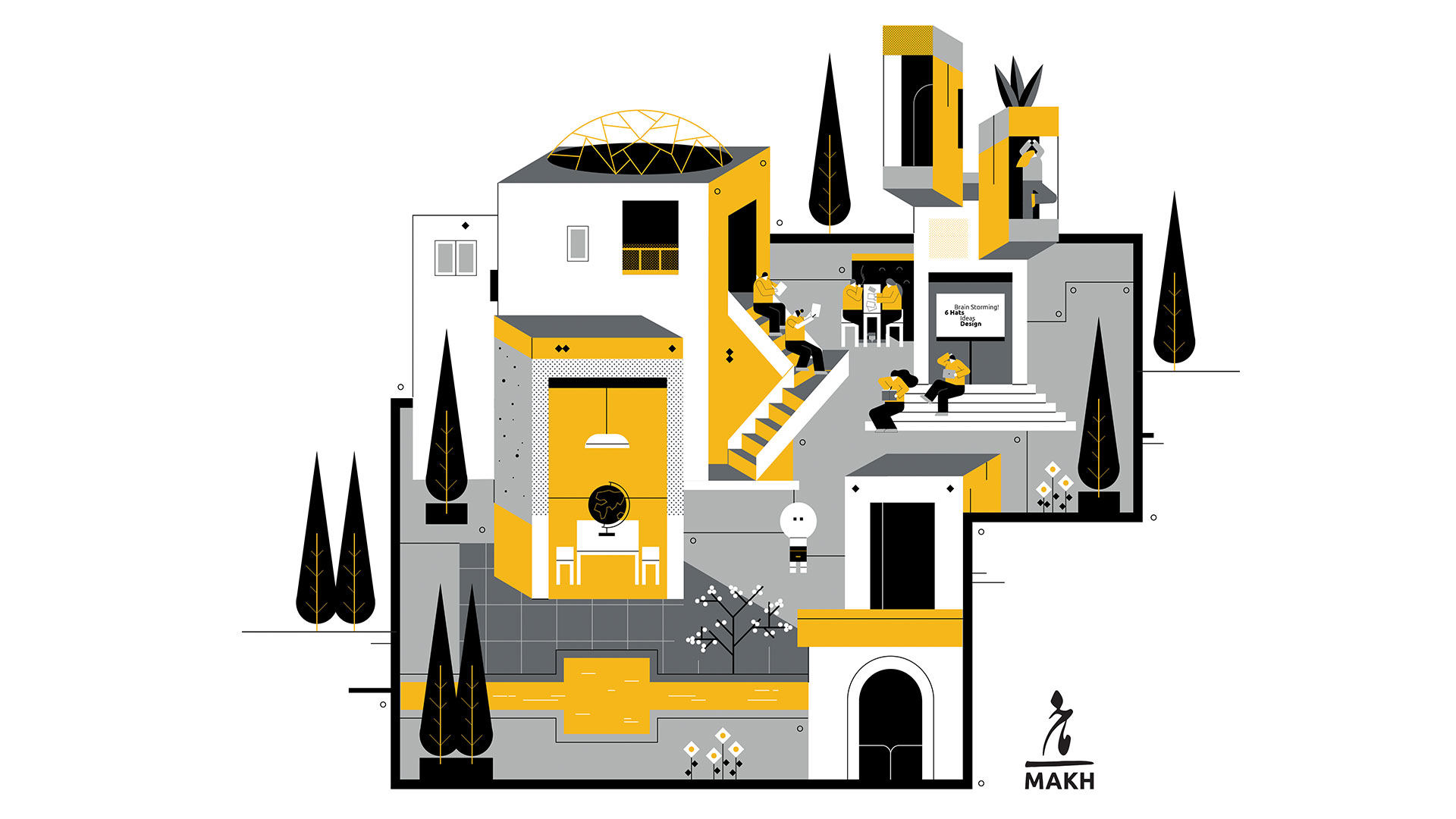

Some say that ideas are only 10% of the whole work and they are not that much valuable.
This may, in a way, resolve all the controversy over “stealing ideas.”
But we can not deny that many of the world’s top businesses are successful and famous because of their groundbreaking ideas.
But the importance of ideas goes further. Every problem, small or big, personal or social or organizational, needs a solution.
And usually, none of these problems have a specific formula for solving.
This is where our problem-solving power lies in our ability to find creative solutions.
From internal problems to customer dissatisfaction with a product or service, they are all waiting for us to provide a solution; An idea!
This is exactly what the third phase of the design thinking process is about.
We have already referred to the phases of empathy and defining the problem.
Moreover, we said that in order for any business to offer something to its audience based on the audience’s needs.
It must first scrutinize the problem, find that hidden need, explore the roots of the problem, and finally, in the third phase, look for a good solution.
This good solution will be created during the ideation phase.
But where do these ideas come from?
Where exactly is the ideation engine in our brains and where should we read the instructions to turn it on?
Do we all have this engine at all?
The best and shortest answer to these questions is that if we let go of our mental assumptions, we will see that golden engine of ideation and creativity right in front of us!
From now on, our minds will do almost everything that is needed to discover or create an idea.
We just need to exercise it over time to come up with better ideas.
So maybe before we start looking for ideas, we should try to break the assumptions and boxes surrounding us!
The good news is that many of the ideation tools used in design thinking work based on breaking the assumptions and habits, and “thinking outside the box.”
Before we get into the introduction of some of these tools, it is good to know the structure of the idea well and see where the ideas come from.
What is an idea?
Creative ideas are just a new combination of old elements. Creativity is basically formed from here:
putting old elements together in a new way that creates a new concept. Consider Uber, for example.
The Internet already existed, as did the taxis. But online taxis were an innovative idea that created a global business.
We can say that the novelty of the idea we create depends to some extent on its raw materials.
That are the same old elements that we have combined.
The more obvious the connection between these existing elements, the more commonplace the idea created.
Discovering invisible and hidden relationships between elements is one of the things that helps you come up with better ideas.
And this means looking at things from new perspectives.
James Webb Young, a creative theorist in the field of advertising and creativity, states in his book “A Technique for Producing Ideas”:
“The important thing about combining old components and producing something new is to be well aware of the relationships between them. […]
In other words, the capacity to integrate old elements into a new set depends largely on understanding relationships.
This is where minds split into many levels when they come up with ideas. For many minds, each fact consists of a separate set of information.
But for the rest of them, the reality is a chain of interconnected information that has similarities and connections.”
In this regard, there is a theory stating that people who have less control over their attention and focus are genetically more creative.
A study of Harvard students showed that nearly 90% of those who showed unusually high creative achievements scored below average in latent inhibition which is the freedom from distraction.
The reason lies precisely in their ability to discover creative connections between elements.
Less focus on plain expression means that one cannot distinguish between the main content to be considered and the trivial sub-contents.
Just like a student who, instead of paying attention to the text of the book, immerses himself in irrelevant images and its layout, because in his view the text of the book is “related” and “inseparable” to its illustrations and layout.
This is where the power of “indivisibility” helps us to see invisible connections between phenomena instead of “seeing them apart.”
This is where creative ideas spark.
One way to increase the capacity of the mind for combining old elements is to have various and different experiences.
Trying out activities you have never done before, reading about a subject that is completely unrelated to your profession, an adventurous trip, learning a new skill that seems to have nothing to do with your job or skills, and watching a movie that does not fit into your usual genre can all help your mind to build an archive of various data.
This charges your mind to create amazing ideas. Also, forming multidisciplinary and interdisciplinary teams for idea generation, in a way, increases this diversity of ideas and innovation.
Say No to “the usuals”
“The usuals” are the serial killer of creative ideas.
As long as you think about your one and only usual choices, you are closing the door on all other creative possibilities.
Consider how you are limiting yourself. Going for “the usuals” creates limited thinking, a limited solution, and consequently a limited business.
This is where you need to escape from your safe zone.
This safe zone, despite its name, is the most dangerous place you can choose to stand when searching for ideas!
But as soon as you step outside the safe zone, you experience fear.
You may be thinking to yourself, “All this time is being wasted on ridiculous ideas.
This is a waste of time and money. Why should we abandon our usual solution and spend energy on something new that may not even work?”
The answer is: because learning and growth take place right outside the safe zone.
Just when the fear of going beyond the known and stepping into the land of the unknown overwhelms you, pure ideas that you had never thought of before come to you.
This is perhaps the most important prerequisite for ideation:
let go of all assumptions and default constraints, and wander beyond the barriers you created for your mind.
A step-by-step map for ideation
This map is not going to take you to the hidden treasure of ideas.
But it will guide you through the land of ideas and make you look for innovative ideas in the right place.
Different ideation tools have different processes and use different paths to get you to the magical land of ideas.
But in almost all of these tools, we can see some common elements:
- Put the redefined problem statement in front of you.
- Dismiss all your assumptions about the solution.
- Take even the most ridiculous or silly ideas seriously and talk about them. Sometimes pioneering ideas are created by combining and developing these seemingly ridiculous ideas that everyone has underestimated.
- Postpone judging the ideas. Judging an idea right when it’s being created is like burning a bud before it grows to know if it is a weed or not.
- Be patient. Getting started may be harder than you thought. But the ideation engine will work better over time.
- Do not be afraid of the mess! This stage is clumsy and messy, but everything will be in its place at the end.
- Start divergent. First, come up with ideas limitless. Once you have enough exploration of the adventure among new and unknown ideas, you will gain insight into the direction of the final idea. This is where you can put the “do’s and don’ts” of the problem statement in front of you and converge the ideas according to these do’s and don’ts.
Ideation tools, acceleration shortcuts
The rest of this post is a brief introduction to some ideation tools and methods.
Ideation tools in design thinking act as shortcuts that guide us through our wanderings and adventures for finding ideas.
You have probably heard about “brainstorming”.
Brainstorming is the starting point of many ideation tools that focus primarily on increasing the number of ideas.
Holding brainstorming sessions also needs special preparations that we will address in the future.
“SCAMPER” is another tool for ideation that has the element of “change” at its core.
This tool uses 8 different ways to create an idea: Substitute, Combine, Adapt, Modify, Put to another use, Eliminate, and Reverse.
“Mind mapping” is a tool that is particularly effective in discovering the relationships between elements and concepts.
In short, in this tool, you put all your thoughts in a graphic organizer and by expanding this diagram you will reach new solutions.
And finally, let’s talk about an unusual tool.
“Reverse Thinking” is one of the tools that facilitates and accelerates thinking outside the box.
Suppose our problem statement is: “How might we make our online courses more accessible?”
To reverse the problem, instead of thinking about the answer to the above question, think about this question:
“How might we make taking our online courses as difficult for our participants as possible?”
This tool helps you figure out what not to do instead of seeing what you need to do!
There is still a lot to be said about the ups and downs and tricks of the idea generation process, reaching the right idea that will delight you and your user, and evaluating the ideas.
But for now, we end with this question: Suppose that we came up with lots of good ideas; So how do we choose the best idea?!
Design thinking has an efficient answer to this question that we will address in the future.
By: Kosar Moghanian




